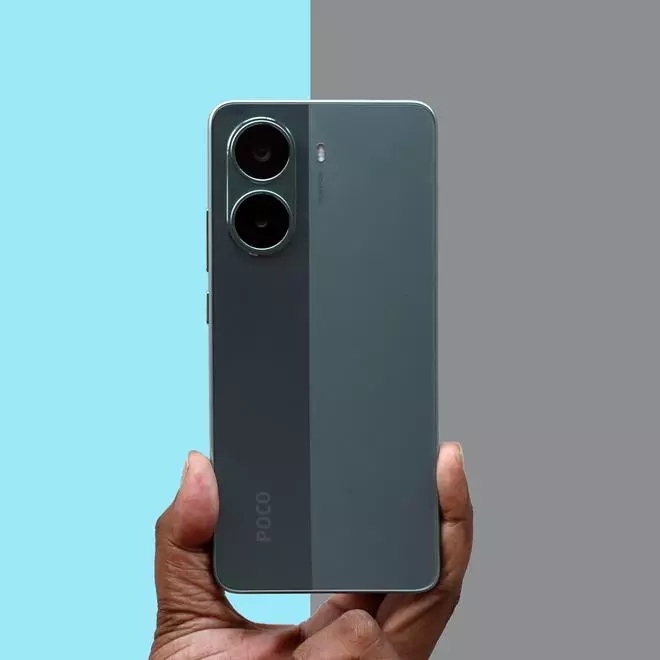In the crowded mid-range smartphone market, POCO has consistently managed to make indents. This year is no different with the launch of the POCO X7 Pro right at the beginning of the new year. With a host of premium features, in a not-so-premium price tag, here’s what makes the POCO X7 Pro stand out — and where it falls short.
Build
The POCO X7 Pro has a polycarbonate body weighing around 198 grams, balancing durability with comfort. It’s designed to endure occasional drops from typical heights, such as a table or desk. The phone’s flat screen and rounded edges also provide a comfortable in-hand feel. While these design elements are fairly common in this price range, they remain functional and practical for everyday tasks. The Nebula Green variant I tested stood out aesthetically, with its unique colour and a smooth matte finish at the rear.

Display
The POCO X7 Pro has a 6.67-inch CrystalRes AMOLED display. The bright display with vibrant and accurate colours made watching PaatalLok (Season 2) on Amazon Prime a great experience. I was particularly impressed by the display’s ability to capture vibrant day scenes and subdued night cinematography in engaging colours. The speakers deliver a decent balance between vocals and instruments, particularly evident in the rock version of Sakhi Mori by DigV and Sparsh Agrawal from the Bandish Bandits. While instruments come through clearly and without distortion at high volumes, vocals though loud and clear sometimes lack depth on the smartphone.
Performance
The POCO X7 Pro features the Dimensity 8400-Ultra processor and the review unit I used had 12 GB RAM and 512 GB storage. In synthetic benchmarks like AnTuTu, the POCO X7 Pro scored around 15,02,758 points, placing it in the vicinity of Samsung Galaxy S23+ and Xiaomi 13(15,13,577) in terms of raw performance.
Playing Genshin Impact was quite smooth, with the smartphone maintaining a consistent 75-90 fps over an hour of gameplay. Though it got noticeably warm during this time window, it also cooled pretty fast, possibly owing to the upgraded LiquidCool Technology 4.0 and POCO 3D IceLoop system for better heat transfer.

The POCO X7 Pro is the first device out with the Xiaomi HyperOS 2. The new operating system introduces more AI-powered tools, improved cross-device connectivity and a redesigned user interface. Although the iconography feels a bit outdated, the interface itself is smooth and easy to use, with no stuttering when navigating between screens and apps. As for bloatware, there are several pre-installed third-party games but they can be easily uninstalled.
The upgraded AI eraser performs fine on static, well-defined subjects but struggles with more complex elements like reflections. The AI Subtitle feature also does a pretty decent job. The AI interpreter helps translate speakers in different languages. While these AI features are useful, you need an active internet connection to access them.
Camera
The POCO X7 Pro features a 50 MP main camera with OIS and an 8 MP ultra-wide rear camera. In terms of image quality, the POCO X7 Pro delivered great shots in bright daylight. In indoor mixed lighting, however, image sharpness and details suffer. Subjects often lack definition and highlight areas tend to be blown out, especially in outdoor daylight shots.
The 20 MP front camera selfie camera shot images at the default 5 MP. While it retains a fair amount of details in wider selfies, those cropped in tend to lose sharpness. Both edge detection and subject sharpness overall were a hit or a miss.
Battery
The POCO X7 Pro has a 6,550 mAh battery. It lasts up to two working days. You get around eight hours of screen-on time with calls, videos, Spotify, photos and VOIP calls. Standby time is almost two days. The phone includes a 90W HyperCharge USB-C charger. It charges fully in about 40 minutes.
Verdict
Priced ₹27,999, the POCO X7 Pro offers near flagship-level performance despite the mid-range price tag. It features a bright AMOLED display, a strong primary camera and the smooth HyperOS 2. However, it faces stiff competition from the likes of Redmi Note 14 Pro 5G, OnePlus Nord 4 and Motorola Edge 50, making it a compelling but not the sole option in this range.












